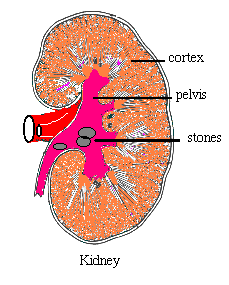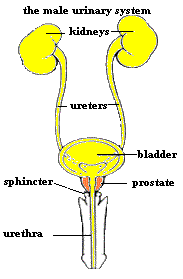H.T. Kurkjian, M.D.
Kidney Stones
Hosted by OKdrs.com
_____________________________________________________________________________________
Dr. Kurkjian fast facts and information
[Kurkjian Home][Kurkjian FAQ][Kurkjian Services]
_____________________________________________________________________________________
Kidney Stones
 |
Kidney stones are calcifications in the urinary system that can cause
pain, infection and, at times, can be dangerous enough to cause death. Kidney stones
can be in any location in the urinary system. Kidney stones in the kidney proper |
 |
Stones in the ureter Mid-ureter |
Stones in the lower part of the ureter
Stones in the lower part of the ureter are usually removed by a basket procedure.
This procedure consists of a basket that is packed inside a small catheter. The
catheter is passed through a cystoscope inside the bladder and then up the ureter.
It is inserted behind the stone so when it is opened, like an umbrella, it will catch the
stone and bring it out. Sometimes it becomes necessary to dilate the ureter as in
angioplasty to be able to insert a ureteroscope and remove the stone. It may become necessary to use laser in conjunction with a catheter that needs to
be placed very close to the stone. Consequently, laser procedures cannot be
used through the body like shock wave treatment.
Bladder stones
Bladder stones can usually be broken up by a machine called a Lithotriptor, laser, electro-hydraulic machines or can be removed by surgery.
Stones in the prostate
Stones in the prostate are embedded in the substance of the prostate and cannot
be removed or pulverized. They usually are removed by removal of the prostate.
Surgical indications
- Fever - If fever develops during the course of the patients illness with a kidney stone or ureter stone, it means that area behind the stone has become infected. The urine behind the stone will contain pus and bacteria. If the bacteria gets into the blood stream a very dangerous and life threatening condition called bacteremia can occur. So, if fever develops, an operation is usually performed on the patient within 24 to 48 hours.
- Pain - Some recurring pain is to be expected in the beginning. However, intervention will be required if the pain is such that, over a 48 hour period, intramuscular or IV injections are required to control the pain.
- Obstruction - If the kidney is totally blocked and there is no pain or fever, treatment can wait a while. However, if treatment is delayed to long, kidney damage can occur.
- Intervention - The pain due to a kidney stone is rarely ever due to the kidney stone itself. It is usually due to the distention or swelling of the kidney and the ureter behind the point of blockage. That is why sometimes, even if the stone is still retained, the pain may disappear for days because the urine is able to drain around the stone.
Management
- Pain pills or shots as needed.
- Fluids should be cut down in the beginning until the sever pain subsides. Then fluids can increased. Sometimes there is nausea, abdominal discomfort and bloating. These are all caused by the stone.
Prevention
After the stone is removed it is sent for analysis. Sometimes, it becomes necessary to study the urine and the blood to determine the cause of the specific type of stone formation. This is specially important as there are more than one type of stone. The metabolic study of kidney stones consists of 24-hour urine and blood collections.
- The patient is instructed to collect 24-hour urine on a regular diet. This is done from 7:00 a.m. one day to 7:00 a.m. the next day. After the urine is collected the patient brings the urine to the lab. A blood specimen may be requested too. After completing this the doctor will see the patient in the office where results are discussed and he or she is placed on a special diet or given special tablets. While on this diet or tablets, another 24 hour urine is collected to make sure the diet or tablets are working. If not, the dose or diet is adjusted. This treatment usually lasts from six months to one year. Most patients who have done this metabolic work up have done very well and not had any recurrent kidney stones.
Disclaimer: Although OKdrs.com undertakes reasonable efforts to keep the information contained herein accurate, Okdrs.com does not warrant the accuracy, completeness, timeliness or merchantability or fitness for a particular purpose of the information contained herein nor in any way endorse the individuals described herein . In no event shall Okdrs.com be liable to you or anyone else for any decision made or action taken by you in reliance on such information. The above warranties are the only warranties of any kind either expressed or implied including warranties of merchantability or fitness for any particular purpose.